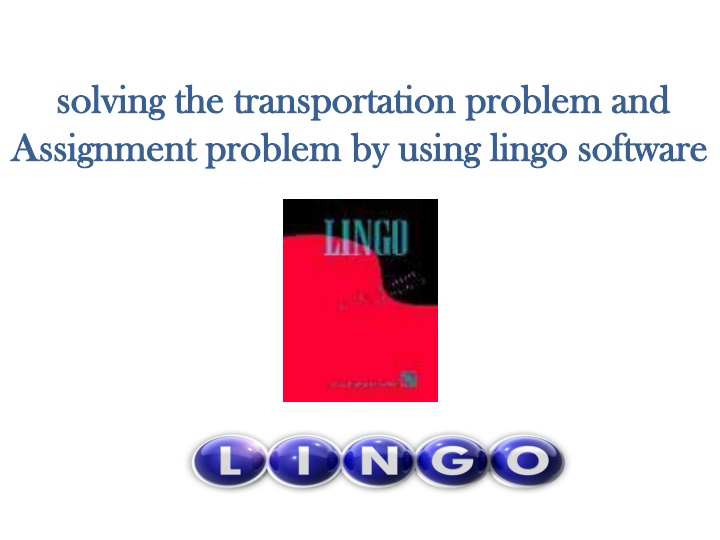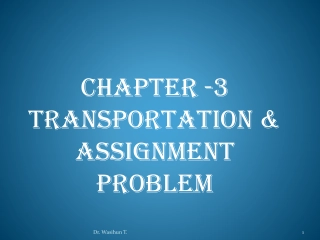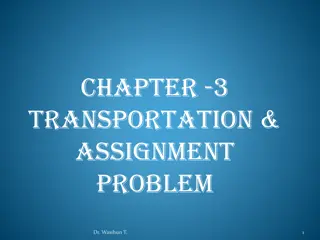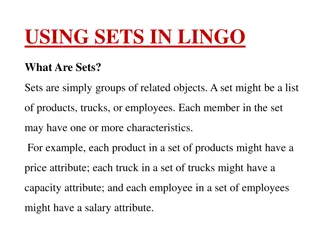Optimization of Transportation and Assignment Problem using LINGO Software
Explore the process of solving transportation and assignment problems using LINGO software with a detailed example involving warehouses, vendors, demands, and transportation costs. Understand the objective function and constraints through mathematical notation and corresponding LINGO syntax. Construct a complete LINGO model for optimization, encompassing objectives, demands, and capacity constraints.
Download Presentation

Please find below an Image/Link to download the presentation.
The content on the website is provided AS IS for your information and personal use only. It may not be sold, licensed, or shared on other websites without obtaining consent from the author.If you encounter any issues during the download, it is possible that the publisher has removed the file from their server.
You are allowed to download the files provided on this website for personal or commercial use, subject to the condition that they are used lawfully. All files are the property of their respective owners.
The content on the website is provided AS IS for your information and personal use only. It may not be sold, licensed, or shared on other websites without obtaining consent from the author.
E N D
Presentation Transcript
solving the transportation problem and solving the transportation problem and Assignment problem by using lingo software Assignment problem by using lingo software
Example 15: A manufacturer has 4 warehouses and 5 vendors all in different cities. In the first warehouse there are 50 products, in the second warehouse there are 70 products, in the third warehouse there are 90 products and in the fourth warehouse there are 90 products. Demand of the first vendor is 80 products, demand of the second vendor is 50 products, demand of the third vendor is 60 products, demand of the fourth vendor is 70 products and demand of the fifth vendor is 40 products. Unit transportation costs from the warehouse to the vendor are given in the following table. V1 V2 V3 V4 V5 WH 1 WH 2 WH 3 WH 4
The objective function : by using mathematical notation, you can express the objective function equation as following: Xij In a similar manner, LINGO s modeling language allows you to express the objective function in a form that is short, easy to type, and easy to understand. The equivalent LINGO statement is: MIN = @SUM(LINKS(I,J): COST(I,J) * X(I,J)); The following table compares the mathematical notation to the LINGO syntax for our objective function: X Xij
The Constraints: Starting with the demand constraint for Vendor 1, we need to sum up the shipments from all the warehouses to Vendor 1 and set them equal to Vendor 1 s demand of 80 UNITS Using mathematical notation, all f ve demand constraints can be expressed in the single statement: Xij The corresponding LINGO modeling statement as @FOR(VENDORS(J): @SUM(WAREHOUSES(I): X(I, J)) = DEMAND(J)); x Xij
Now, we will move on to constructing the capacity constraints. In standard mathematical notation, the four capacity constraints would be expressed as: < Xij The equivalent LINGO statement for all capacity constraints would be: The equivalent LINGO statement for all capacity constraints would be: @FOR(WAREHOUSES(I): @SUM(VENDORS(J): x(I, J))<= CAPACITY(I)); Putting together everything we ve done so far yields the following complete LINGO model: MODEL: MIN = @SUM(LINKS(I, J): COST(I, J) * x(I, J)); @FOR(VENDORS(J): @SUM(WAREHOUSES(I): x(I, J)) = DEMAND(J)); @FOR(WAREHOUSES(I): @SUM(VENDORS(J): x(I, J)) <= CAPACITY(I)); END
Solving the Transportation Model Now, let s solve the model to determine the optimal shipping volume for each warehouse to vendor link. In LINGO for Windows, choose Solve from the LINGO menu or press the Solve button . Note: To obtain a report containing only the nonzero values for x, we select the Solution command from the LINGO menu. We are then presented with the following dialog box: x Press down on the arrow button in the Attribute or Row Name field and select x from the list of names in the drop-down box.
Example: Suppose that we have 5 jobs (1, 2, 3, 4, 5) waiting for being performed and 5 machines (A, B, C, D, E) that can be used to perform these jobs. The assignment costs of the jobs to the machines are given in the following table. Find the minimum total cost one-to-one assignment between the jobs and the machines by the Hungarian Method.
SETS JOBS / J1 J2 J3 J4 J5 /; MACHINE / A B C D E / ; LINKS(JOBS , MACHINE): COST, X; ENDSETS The objective MIN = @SUM( LINKS( I, J): COST( I, J) * X( I, J)); The demand constraints @FOR( JOBS( I): @SUM( MACHINE (J): X( I, J)) =1);
The capacity constraints @FOR( MACHINE (J): @SUM( JOBS ( I): X( I, J)) =1 The data DATA: COST = 9 6 3 3 4 4 5 6 9 7 7 8 11 2 8 6 7 12 5 13 4 5 6 4 9 ; ENDDATA END























